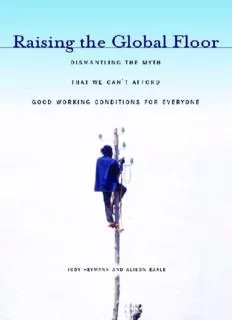
Raising the Global Floor: Dismantling the Myth That We Can't Afford Good Working Conditions for PDF
Preview Raising the Global Floor: Dismantling the Myth That We Can't Afford Good Working Conditions for
R aising the g lobal FlooR R a i s i n g t h e g lo b a l Flo o R Dismantling the Myth that We Can’t Afford Good Working Conditions for Everyone Jody heymann and alison earle stanFoRD PolitiCs anD PoliCY an imprint of stanford University Press stanford, California Stanford University Press Stanford, California © 2010 by Jody Heymann and Alison Earle. All rights reserved. No part of this book may be reproduced or transmitted in any form or by any means, electronic or mechanical, including photocopying and recording, or in any information storage or retrieval system without the prior written permission of Stanford University Press. Printed in the United States of America on acid-free, archival-quality paper Library of Congress Cataloging-in-Publication Data Heymann, Jody, 1959- Raising the global floor : dismantling the myth that we can’t afford good working conditions for everyone / Jody Heymann and Alison Earle. p. cm. Includes bibliographical references and index. ISBN 978-0-8047-6890-0 (cloth : alk. paper) 1. Employee rights. 2. Labor policy. 3. Labor laws and legislation. 4. Labor economics. I. Earle, Alison. II. Title. HD6971.8.H49 2010 331.2--dc22 2009029789 Typeset by Bruce Lundquist in 10/14 Minion to Margaret Mead, for reminding us all of the potential of small groups of people to begin to change the world in ways that matter to our research team, for living this belief and to you, for carrying the ball the next yard the natural distribution is neither just nor unjust; nor is it unjust that persons are born into society at some particular position. these are simply natural facts. What is just and unjust is the way that institutions deal with these facts. John Rawls (1921–2002) Contents Preface ix 1 the struggle below the surface: Declining Working Conditions 1 PaRt i: eXaMining the Contentions FeeDing inaCtion 2 the argument that humane Working Conditions lead to higher Unemployment 23 3 the Contention that Countries Can’t Compete if they Protect Working adults 46 4 the Myth that labor laws Do not Make a Difference 70 PaRt ii: ReQUiReMents FoR Change 5 achieving global Consensus 89 6 addressing Where the World lags behind 121 7 Moving from evidence to action: Raising the Floor of Working Conditions and equity 147 viii Contents appendix 163 acknowledgments 171 notes 177 index 227 Preface Making Fundamental Rights Count While the twentieth century was marred by some of history’s worst violence— repeated genocides underscoring one group’s ability to utterly dehumanize another—and by neglect that led to millions of preventable deaths each year, it was also a century in which people from every nation, religion, and ethnic group around the world came together for the first time to recognize com- mon human rights. Hopes turned into promises. These collective aspirations were embodied in global agreements through the United Nations and other international organizations, but those same bodies had little direct control over translating the dreams of basic rights into daily realities. The respon- sibility to ensure equal rights irrespective of gender, class, race, ethnicity, or religion; to prevent discrimination on the basis of disability; and to ensure access to health, education, and decent working conditions continues to fall primarily on the shoulders of individual countries. Have the promises been kept? Little information has been systematically gathered regarding countries’ efforts to improve equity. Through human rights organizations and other like-minded institutions, civil society has be- gun to document and publicize violations of political and civil rights; how- ever, far fewer efforts have been made to track progress in achieving social and economic rights across societies. In the first decade of the twenty-first century, there are few places to which one may turn for readily accessible, ix
Description: